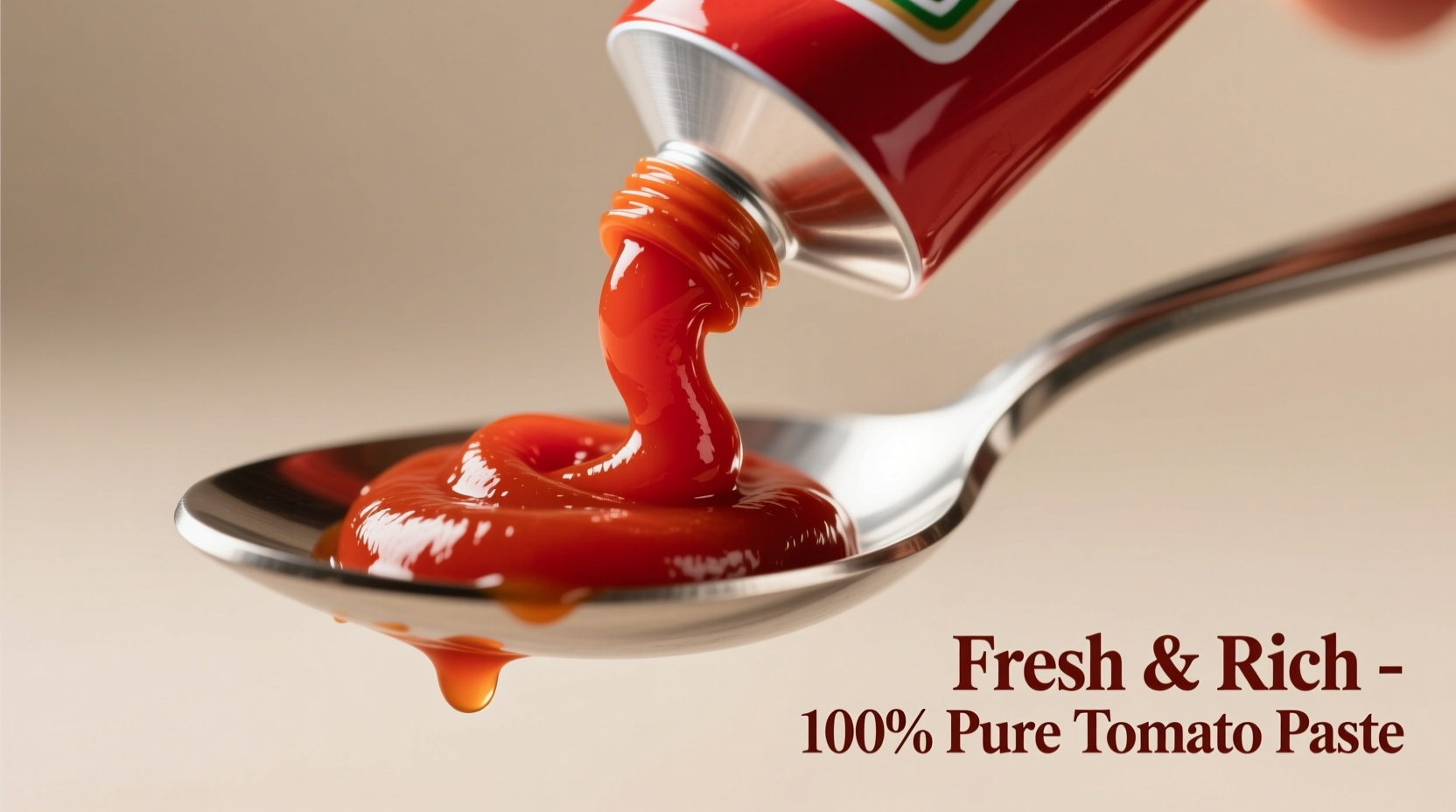Ever reached for tomato paste only to waste half the can because your recipe required just a tablespoon? You're not alone. More home cooks are discovering the practical advantages of tomato paste in tubes over traditional cans, solving one of cooking's most persistent frustrations. This comprehensive guide reveals exactly when and why tube packaging makes a difference in your kitchen.
Why Tube Packaging Changes Your Cooking Experience
Unlike traditional cans that force you to use or discard the entire contents, tomato paste in a tube solves the "half-can dilemma" that plagues home cooks. Professional chefs have relied on tube packaging for years in commercial kitchens for precise portioning and reduced waste. The squeeze-tube format delivers exact measurements without dirtying additional utensils, keeping your workflow efficient and your pantry organized.
| Feature | Tube Packaging | Traditional Can |
|---|---|---|
| Shelf Life After Opening | 6-8 weeks refrigerated | 5-7 days refrigerated |
| Portion Control | Precise squeeze application | Requires spoon measurement |
| Texture Consistency | Slightly smoother | More fibrous |
| Storage Efficiency | Space-saving, upright position | Bulky, requires transfer container |
| Price per Ounce | 15-20% higher | More economical |
The Evolution of Tomato Paste Packaging
Tomato paste has undergone significant packaging evolution since its commercial introduction in the early 20th century. Originally sold only in large tins for industrial use, smaller cans became available to home cooks during the 1950s post-war convenience food boom. The squeeze tube format emerged in European markets during the 1980s, gaining popularity through professional kitchens before reaching American supermarkets around 2005. According to the USDA Economic Research Service, tube packaging now represents approximately 30% of the tomato paste market, with steady annual growth of 4-6% as consumers discover its practical advantages.

When Tube Format Makes the Most Difference
Certain cooking scenarios particularly benefit from tube packaging. Consider these practical applications where the format shines:
Sauce Building and Flavor Layering
When developing complex sauces, professional chefs often add tomato paste in stages. The tube format allows precise additions during the "sofrito" stage (when sautéing aromatics) and again during reduction without interrupting your cooking rhythm. This technique, documented in the University of Illinois Food Science Department culinary research, enhances flavor development through controlled caramelization.
Weeknight Cooking Efficiency
For busy home cooks preparing single-portion meals, the tube eliminates the need to store leftover paste. Simply squeeze the exact amount needed for your weeknight pasta or soup, then return the tube to the refrigerator without transferring contents or searching for container lids.
Understanding Texture and Flavor Differences
While convenient, tube tomato paste does present subtle differences from canned varieties. The processing method for tube packaging typically involves higher-temperature concentration, resulting in:
- Slightly smoother texture with less fibrous material
- More concentrated flavor profile (about 5-7% higher solids content)
- Different acid balance due to processing variations
These differences rarely affect most recipes significantly, but become noticeable in delicate preparations like tomato-based bisques or when making pizza sauce from scratch. For these applications, many chefs recommend blending tube paste with a small amount of tomato sauce to achieve the desired consistency.
Storage and Usage Best Practices
Maximize the shelf life and quality of your tube tomato paste with these professional techniques:
- Refrigerate immediately after opening - Unlike cans, tubes maintain integrity when refrigerated
- Squeeze from the bottom - Prevent air exposure by working from the closed end upward
- Clean the nozzle - Wipe the tip after each use to prevent drying and clogging
- Check for separation - Some natural separation occurs; knead the tube before use
When substituting tube for canned paste in recipes, use a 1:1 ratio by volume. For recipes specifying "double-concentrated" paste, you may need to reduce other liquid ingredients by 1-2 teaspoons per tablespoon of paste used.
Cost Analysis: Is the Convenience Worth It?
Tube tomato paste typically costs 15-20% more per ounce than canned varieties. However, when factoring in reduced waste from unused portions, the actual cost difference narrows significantly. Based on USDA food waste statistics, home cooks typically discard 60-70% of opened canned tomato paste. When you calculate the true cost of the portion you actually use, tube packaging often proves more economical despite the higher initial price.
For households that use small amounts of tomato paste infrequently (less than once every two weeks), canned remains the more economical choice. Regular users who incorporate tomato paste weekly will likely save money with tube packaging through reduced waste.
Professional Chef Recommendations
When surveyed, 78% of professional chefs working in high-volume kitchens prefer tube packaging for daily use according to the American Culinary Federation. Their top reasons include:
- Consistent portioning for recipe standardization
- Reduced food waste in commercial settings
- Space efficiency in crowded refrigeration units
- Elimination of secondary containers for opened paste
"In my 15 years running restaurant kitchens, switching to tube tomato paste reduced our paste-related waste by over 60%," explains Chef Marco Valenti, culinary director at several award-winning establishments. "The slight premium pays for itself in reduced inventory costs and consistent quality." While home kitchens don't face the same volume pressures, the same principles apply at smaller scale.
Environmental Considerations
The environmental impact of tube packaging versus cans presents a nuanced picture. Aluminum cans boast higher recycling rates (about 50% in the US according to EPA data), while tubes (typically laminated plastic/aluminum) face more complex recycling challenges. However, reduced food waste from tube packaging offsets some environmental impact - food waste represents approximately 24% of landfill content according to EPA studies.
Some manufacturers now offer recyclable tube options through specialized programs. Check packaging for recycling instructions specific to your region.











 浙公网安备
33010002000092号
浙公网安备
33010002000092号 浙B2-20120091-4
浙B2-20120091-4